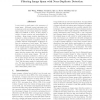Free Online Productivity Tools
i2Speak
i2Symbol
i2OCR
iTex2Img
iWeb2Print
iWeb2Shot
i2Type
iPdf2Split
iPdf2Merge
i2Bopomofo
i2Arabic
i2Style
i2Image
i2PDF
iLatex2Rtf
Sci2ools
CEAS
2007
Springer
2007
Springer
Filtering Image Spam with Near-Duplicate Detection
A new trend in email spam is the emergence of image spam. Although current anti-spam technologies are quite successful in filtering text-based spam emails, the new image spams are substantially more difficult to detect, as they employ a variety of image creation and randomization algorithms. Spam image creation algorithms are designed to defeat well-known vision algorithms such as optical character recognition (OCR) algorithms whereas randomization techniques ensure the uniqueness of each image. We observe that image spam is often sent in batches that consist of visually similar images that differ only due to the application of randomization algorithms. Based on this observation, we propose an image spam detection system that uses near-duplicate detection to detect spam images. We rely on traditional anti-spam methods to detect a subset of spam images and then use multiple image spam filters to detect all the spam images that “look” like the spam caught by traditional methods. ...
| Added | 07 Jun 2010 |
| Updated | 07 Jun 2010 |
| Type | Conference |
| Year | 2007 |
| Where | CEAS |
| Authors | Zhe Wang, William K. Josephson, Qin Lv, Moses Charikar, Kai Li |
Comments (0)

